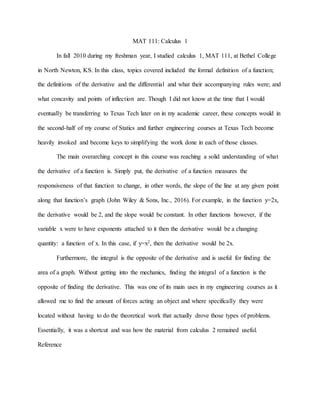
MAT 111 Calculus 1 Course Overview
- 1. MAT 111: Calculus 1 In fall 2010 during my freshman year, I studied calculus 1, MAT 111, at Bethel College in North Newton, KS. In this class, topics covered included the formal definition of a function; the definitions of the derivative and the differential and what their accompanying rules were; and what concavity and points of inflection are. Though I did not know at the time that I would eventually be transferring to Texas Tech later on in my academic career, these concepts would in the second-half of my course of Statics and further engineering courses at Texas Tech become heavily invoked and become keys to simplifying the work done in each of those classes. The main overarching concept in this course was reaching a solid understanding of what the derivative of a function is. Simply put, the derivative of a function measures the responsiveness of that function to change, in other words, the slope of the line at any given point along that function’s graph (John Wiley & Sons, Inc., 2016). For example, in the function y=2x, the derivative would be 2, and the slope would be constant. In other functions however, if the variable x were to have exponents attached to it then the derivative would be a changing quantity: a function of x. In this case, if y=x2, then the derivative would be 2x. Furthermore, the integral is the opposite of the derivative and is useful for finding the area of a graph. Without getting into the mechanics, finding the integral of a function is the opposite of finding the derivative. This was one of its main uses in my engineering courses as it allowed me to find the amount of forces acting an object and where specifically they were located without having to do the theoretical work that actually drove those types of problems. Essentially, it was a shortcut and was how the material from calculus 2 remained useful. Reference
- 2. John Wiley & Sons, Inc. (2016). How to find the derivative of a line. Retrieved from http://www.dummies.com/how-to/content/how-to-find-the-derivative-of-a-line.html